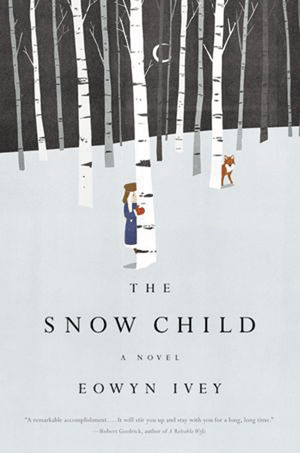The Snow Child
By Eowyn Ivey
Reagan Arthur/Little, Brown and Company
(389 pages, $24.99)
“The Snow Maiden” is a Russian folk tale that has been told, written, sung and danced. Versions exist throughout Europe, but the original story refers to an aging couple, a woodcutter and his wife, who are unable to have a child. One day, they build a child from snow and the child comes alive, only to disappear each spring and reappear with the first snow.
In her debut novel, “The Snow Child,” Eowyn Ivey has taken this tale and woven it into the lives ofMabel and Jack, a middle-aged couple who buried their stillborn child 10 years before the book opens in 1920. They have moved from Pennsylvania to start anew in Alaska, where Jack has built a cabin and cleared some fields. The cabin is surrounded for miles by dark forests.
Mabel’s longing for a child is a focused beam of energy cutting through her days. Jack doesn’t know how to reach her anymore. One night, they build a snowgirl. In the morning, she is gone — mittens, scarf, hat and all. Footprints lead off into the woods.
Ivey, a native Alaskan, knows how to make the frost glow in a window, how to describe light flickering through birches in a way that plays with the reader’s imagination — what is running through the trees at the edge of the clearing? The book is full of reflections in dark windows, lamplight, alpenglow. It “was a beauty that ripped you open and scoured you clean,” Mabel thinks, “so that you were left helpless and exposed, if you lived at all.”
At first it seems that the child, who Jack and Mabel see with increasing frequency at the margins of their clearing, must be a fairy. She leads Jack to a moose, which keeps them alive through a lean winter. She leaves them rabbits and pelts. Mabel makes her a doll. And then, one day, Jack follows her up into the mountains. He learns the secret truth of her existence, and promises to tell no one.
Mabel, whose father was a literature professor, remembers the story of the snow maiden, and asks her sister to send her the book. As she turns the pages, she sees her own story unfolding.
Ivey dives deep into Jack and Mabel’s relationship; how does she keep this aspect of the novel so specific and intimate, even as she tells the story of every mother and father? It could be that because the story is familiar, we think, like Mabel, that we know how it will end. When the story takes a different turn, we are surprised.
Ivey sets up the two most powerful forces in any story: fear on the one hand, potential for the miraculous on the other. Fear vs. Miracle. Which will win?
Send questions/comments to the editors.



Success. Please wait for the page to reload. If the page does not reload within 5 seconds, please refresh the page.
Enter your email and password to access comments.
Hi, to comment on stories you must . This profile is in addition to your subscription and website login.
Already have a commenting profile? .
Invalid username/password.
Please check your email to confirm and complete your registration.
Only subscribers are eligible to post comments. Please subscribe or login first for digital access. Here’s why.
Use the form below to reset your password. When you've submitted your account email, we will send an email with a reset code.